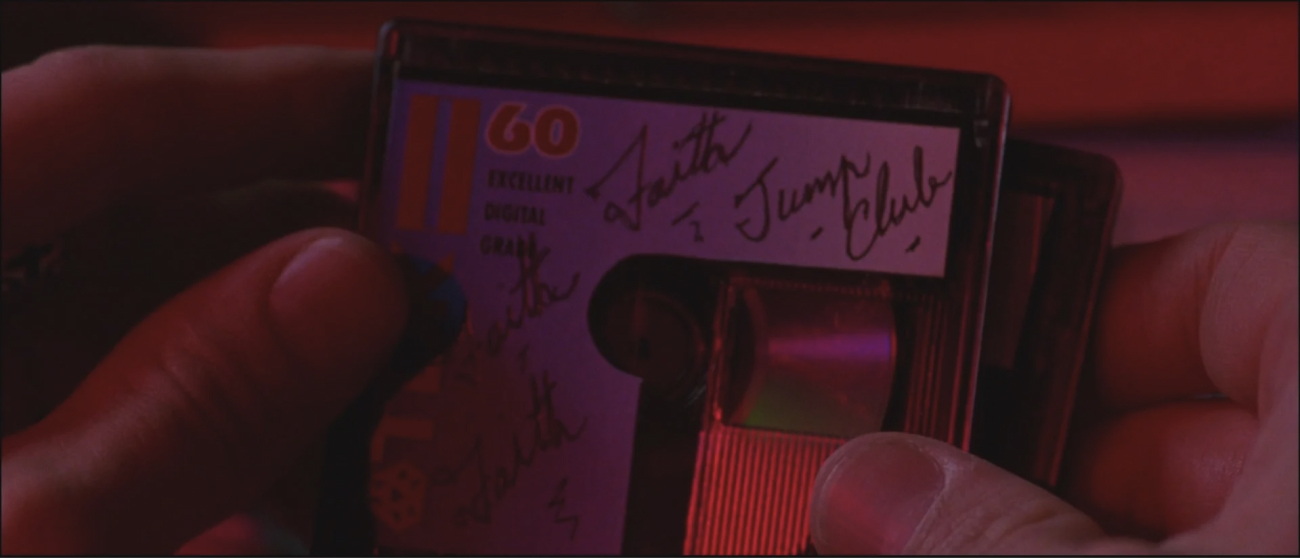Progress Jams
Why most innovation never actually happens.

The MiniDisc’s big moment in Strange Days.
On most evenings in 1999, you might have found me in my dorm room, meticulously crafting a small, but treasured collection of Minidiscs.
I had already ripped my entire CD collection to my computer’s hard drive — in the best format available to me at the time, “True Audio” files (.tta) — and had begun transferring them to blank Minidiscs. What slowed me down was actually the fun part; I took this re-platforming process far further than just copying files and slapping handwritten labels on the sides of the discs. I would find high-res album art images on the web, reformat them in Photoshop to perfectly fit the Minidisc and its case, print my label designs at the school computer lab, carefully trim everything down, and finally, mount them to the disc and case using a glossy lamination film that I swiped from the school’s painting studios (they used them to label bins of turpentine and paint waste). My late-night fabrication line produced pirated discs with a pretty “official” look to them, if I do say so myself. I took pride in there being no Chris’s version of “Tina’s Mix.”
Why did I do this? I don’t know. It was fun, I can be a little type-A, I was pretty good with an X-Acto blade, and media ethics at the time were not very well developed. I also believed that the Minidisc was the future of music. I was wrong about that and, frankly, I’m still a little sad about it.
Few of my friends understood what I was doing. “What the hell is a minidisc?” was the common response I got when asked what I was up to, or what that strange silver square tech was that I carried. After all, the late nineties were a strange time for music formats. For most people at the time, a “music collection” was a zipper-clad, soft-shell binder containing pages of sleeved CDs. But, most of these people were also ravenously scouring Napster for every free MP3 they could find. Most of that stolen music was played on cheap computer speakers using Winamp or Windows Media Player. Some of it was burned to CD-Rs — a writeable CD format that had only become available the previous year — and played on a flimsy, skip-prone portable player called a Discman. I can still see people walking down the street, holding them flat on the palm of their outstretched hand, as if they were carrying a silver platter of hors d’oeuvres.
What we were experiencing was messy. The late 1990s was a time deeply associated with format wars. Everywhere you looked, there was some new tech trying to edge out the old. DVDs challenging VHS. MP3s sideswiping CDs. Internet Explorer vs. Netscape. Dial-up vs. ISDN vs. DSL. Zip drives vs. Jazz. It was like a ten-lane highway crammed with every possible vehicle — a melee of machines, all trying to get to the same place.

50-lane traffic jam in China — Image sourced from Bloomberg.
Progress Jams
Sometimes progress looks a lot like a traffic jam. At any point in time, there are millions of ideas vying to get ahead of one another, many of them racing toward a single destination. And no matter what the “road” is in this metaphor, there’s not enough of it to hold all the traffic. Some ideas are delayed. Some ideas end up carpooling. But what about those that never get where they were going?
The conventional wisdom is that the Minidisc was just a solution to a problem that didn’t exist. After all, by the time it finally made it to the market, new products called into question the very idea of physical media. From one perspective, that basic analysis holds up. Sony’s biggest marketing push to get affordable, $250 Minidisc players into the hands of consumers came at a cost of $30m in 1998. That was the same year that the first portable MP3 players were released, and less than a year before Napster.com went live. All in all, terrible timing. In hindsight, it just looks like the Minidisc never got on the road. However, the Minidisc’s story is a bit more complicated.
The Minidisc’s predecessor, the Compact Disc (CD), was brought to market in 1982. That year, Sony introduced the CDP-101 in Japan. It was a huge success. Over the next two years, Sony sold more than 1 million CD players and 22.5 million CDs. Within six years, there were more CDs sold in the United States than vinyl records, and within ten, CDs had conquered tapes. That gave it another ten years or so to dominate the market before the MP3 fully took over.
Just a year after the first CD player was released, a pair of scientists presented a new kind of erasable magneto-optical disc drive to an audio engineering conference in the Netherlands. This drive was what made the Minidisc better than the CD. It could easily be written and rewritten, just like the hard drive of a computer. Its data compression enabled the same capacity as a CD, but within a disc less than half its size. It included a memory buffer that loaded prior to playback, ensuring that the the disc never skipped. And it was contained in a protective casing that prevented any other physical damage to the disc.
In 1983, the Mindisc was a significant advance over the Compact Disc — the very solution that had only just been shipped to solve the big music format problem at the time: the cassette tape. Cassette tapes just were not holding up. They could easily warp and unspool. They degraded every time a new recording was made. CDs offered better quality, but introduced new flaws. The Minidisc solved those new flaws. It was a better technology, all around, and was a better fit for most consumers than the CD. So why didn’t it succeed?
The Minidisc was stuck behind the CD in a progress jam. They were both going to the same place, and only one was going to get there first. It took Sony ten years to ship a Minidisc player after the technology was invented, and it was during that head start that the CD had so thoroughly dominated the market. This is where the true nature of the progress jam reveals itself.
A progress jam isn’t just an idea and its competitors. It is made up of the idea, its competitors, and all the attendant ideas and industry that come with it.
We Are Stuck in a Progress Jam Now
We have been stuck in a progress jam since 2007. The cause was the iPhone.
Initially, it was the iPhone that merged on to the crowded Smartphone Street, speeding past the Blackberrys and Nokias and Palms and catching everyone’s eye as it did so. But then, as the major phone makers copied the features and form-factor of the iPhone, Smartphone Street widened into Smartphone Superhighway, and was quickly clogged with an increasingly dense and slow-moving crowd of travelers: The supply chain of materials and components, accessories, apps, designers, developers, journalists, media of all kinds, network and regulatory systems, and on and on and on. Imagine, now, trying to merge onto that highway in an entirely new kind of vehicle. Your only recourse might be to bypass it completely.
When I think of the true cost of a progress jam, it’s not just the ideas that got cut off by others in a better position to get ahead, or those that turned back after trying to get there but not making progress. I think about those that never even got started — they looked out at the traffic and decided to stay home instead.
What are the costs of a progress jam? They’re the unmade products, sure. They’re the good products that don’t succeed, too. But they’re also the best minds, mis-applied. They’re also the unthought thoughts, distracted by the necessity of maintaining the calcified machine of older ideas — of pursuing a fortune made by a widget that only makes sense in some old idea’s world.

Sunken ships stuck in the Suez Canal — Image sourced from AmusingPlanet.
The Longest Progress Jam in History
Half a century ago, there was a traffic jam in the Suez Canal that lasted for 8 years. Literally. It took eight years for fifteen cargo ships to make the journey from the Mediterranean to the Red Sea. The increasing congestion of the canal caused a war. Egypt shut down the canal, trapping those fifteen ships mid-journey. There were significant, worldwide economic effects. When the war ended and Egypt finally opened the canal back up to through traffic, it took two more years to clear everything out. Two of the ships caught up in this mess were German ships. Two ships, and their crews, thousands of miles from home for the better part of a decade. Can you imagine what was lost to this traffic jam? Peoples’ lives went in a completely different direction because of it.
Besides the localized jam caused by the iPhone, I have a very strong sense of being caught in a larger progress jam now. Whether it’s a device jam, or an attention jam, or a politics jam, we seem to be stuck at a local maximum that is masquerading as a perpetually uniform sine wave. We know the highs, we know the lows. Fortunes are made at both ends; the even peaks and valleys of a sine wave are an enriching status quo that fundamentally alters perceptions, beliefs, and desires. They are a mental local maximum that cannot be seen past because the illusion is self-propagating. Every time one zooms out from within it, the pattern, like a fractal, repeats.
I wonder whether we will look back upon the last twenty years of cultural and technological traffic in a similar way to the eight year jam in the Suez Canal. Whether we will see all the things that could have been but were not, because of the defining ideas and technologies into whose jam we’ve all been drawn. Whether we will mourn the loss of potentialities, of progress, and of futures. Only time will tell.
Christopher Butler, April 9, 2021
Filed under: Essays